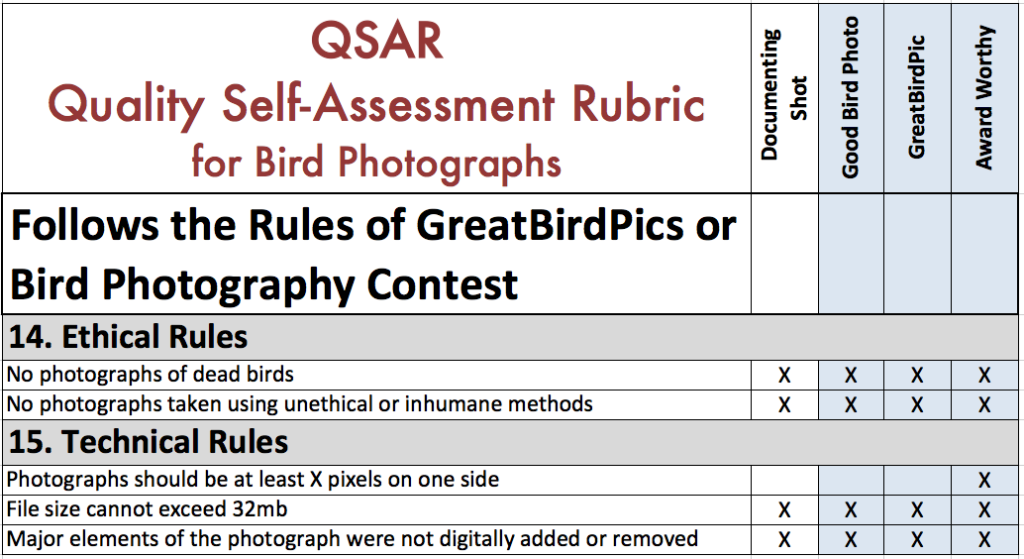There Are Rules To Follow
The final section of the Quality Self-Assessment Rubric (QSAR) for Bird Photographs has little to do with Technical Quality (Components 1-5), Content (Components 6-10) or Artistic Quality (Components 11-13) and focuses on what is permissible and/or expected on GreatBirdPics.com or many bird photography contests (it is recommended you download the rubric to use as a guide from the QSAR Menu item above). In both cases there are rules of what can and cannot be included in submitted images, the parameters of the photograph’s file, and documentation associated with the submission. Some Components below are appropriate for GreatBirdPics.com while others are provided as a “heads up” when entering a photography contest. Below is the final Components of the QSAR:

14. Ethical Rules
There are two points within this Component. One deals with the content of the photograph and the other deals with how the photograph was obtained:
No photographs of dead birds = Applies to all photographs submitted.
This is pretty clear – GreatBirdPics and almost every contest do not accept pictures of dead birds (an exception might be when the contest accepts images of birds negatively affected by a natural or man-made disaster such as an oil spill).
No photographs taken using unethical or inhumane methods = Applies to all photographs submitted.
It may be hard to believe that some people will do anything to get a bird photograph and some of their actions would be considered unethical or inhumane. If you’re been on a group bird walk with bird photographers you’ve probably noticed at least one photographer will walk closer to the bird or move themselves in front of others in their attempt to get a shot of the bird. More often than not their actions might be considered rude.
Unethical behavior usually goes way beyond that. Some bird photographers just care about the shot and not the bird and will disturb the bird when they get too close or use a flash. They don’t even know the type of bird they are photographing – they just want a good shot. This often happens when owls are the subject. As you know, owls hunt at night and rest during the day. Unethical photographers will try to get as close as possible to an owl in the daylight, often disturbing the bird and flushing it away. This makes it less likely for the next birder to actually find the owl. They may get a lot of “Likes” on Facebook or Instagram but their actions are bad for birds.
In some cases a photographer is not only unethical they are also inhumane. One photographer went to a pet store and bought some mice. He then went out into the field and used the mice to capture images of a Snowy Owl as it flew in for the kill. I’m sure whoever bought the pictures didn’t ask how they were obtained.
15. Technical Rules
There are three points within this Component.
Photographs should be at least X pixels on one side = Award Worthy
When entering an image in a contest be sure to read all the rules. In many cases there will be a minimum size, usually defined in pixels. After cropping an image the photo editor you are using should display the horizontal and vertical size in pixels. GreatBirdPics.com does not have a limitation on image size.
File size cannot exceed 32mb = Documenting Shot, Good Bird Photo, GreatBirdPic
Today’s cameras capture a tremendous amount of information which is then saved as a RAW or jpg file. My first digital camera saved each image in a 3mb file and my current camera produces 25mb files. Some newer cameras save each image in 50mb or higher files.
GreatBirdPics.com is designed to accept images up to 32mb. Again, check all contest rules to see what their file limitation might be.
Major elements of the photograph were not digitally added or removed = All four Types Of Bird Photograph
It’s easy to manipulate what an image includes or excludes. There are some people who are masters of Photoshop: they can give an elephant wings and a bird a briefcase. When you read “Major elements…” there is some flexibility there as long as it is not overdone. I’ve added a catchlight to a bird’s eye or removed a distracting twig using Lightroom. That’s OK. Taking the head of one bird and attaching it to the body of another bird is not OK.
Most photography contests include a statement similar to this in their rules. The more prestigious contests will request a copy of the original file and compare it to the photo being considered for a prize before declaring it a winner.
Conclusion
As I look back at the QSAR I recognize some of the information is self-evident and other sections are very subjective. If find it helpful I would appreciate a quick note. You can email me at greatbirdpics@gmail.com
The QSAR rubric and all bird photographs (unless otherwise noted) are copyrighted by Mike Warner.
If you would like to learn more about GreatBirdPics Click Here. Members can post their own great bird pics, create an online gallery of their works, and receive regular emails containing bird photographs taken by our members and topics on how to improve your bird photography.